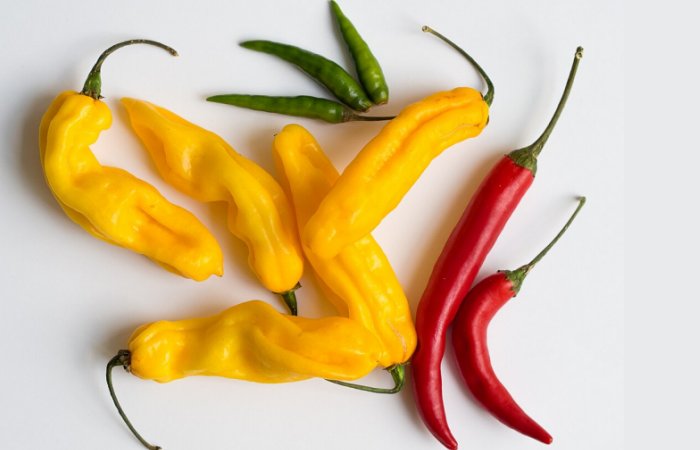Conny Waters – AncientPages.com – The history of the chili pepper is intricately intertwined with the history of humanity in the Americas, according to Dr. Katherine Chiou, an assistant professor in the Department of Anthropology at The University of Alabama.
Relative sizes of chillies: green bird’s eye, yellow Madame Jeanette, red cayenne. Image credit: Takeaway – CC BY-SA 4.0
Chiou presents compelling evidence indicating that the domestication of Capsicum annum var. annum, the species predominantly responsible for most commercially available chilies, took place in a distinct region of Mexico contrary to prior assumptions.
“Typically, what has been preserved in Mexico are extraordinary circumstances like cave sites, for example, that are high and dry with conditions that allow for extraordinary preservation,” Chiou said.
The researchers’ assumption is that the origin of a species’ domestication is the area of greatest diversity.
Preserved cave sites and the diverse range of chili pepper varieties found in the Tamaulipas region of Mexico have contributed to the hypothesis that this area is the origin of Capsicum annuum. This species includes well-known peppers such as jalapeños, poblanos, bell peppers, Thai chilies, and other commercially cultivated chili pepper varieties.
Chiou and collaborators in Mexico have focused on the probable origins of cultivated chili peppers. A significant aspect of their research involves an extensive collection of seeds from contemporary chili pepper species and cultivars, complemented by detailed descriptions of their environmental conditions and cultivation needs.
In this research, the team used electron microscope imaging of archaeological seeds, ecological models dating back 20,000 years, and data from all registered archaeological sites in Mexico, provided by the government.
Two things emerged. First, Tamaulipas, thought to be the origin of this Capsicum species, lacked conditions for wild chili growth during the Holocene when domestication likely began. The data suggest that the lowland near the Yucatán Peninsula and southern coastal Guerrero are more probable sites for early encounters between wild Capsicum and humans.

Seeds from domesticated and wild chili pepper varieties. Seeds are the part of a plant most likely to be preserved in archeological sites and are therefore key to studying the history of plant domestication. Credit: Proceedings of the National Academy of Sciences (2024). DOI: 10.1073/pnas.2413764121
However, Chili pepper domestication is not clearly defined.
“We think it began around 10, 000 years ago or earlier,” said Chiou. “But even in Postclassic Maya times, a continuum between wild and domestic existed.”
Typically, domesticated plants are maintained separately from their wild ancestors. However, chilies have been consistently interbred with wild varieties up until recent times. Certain wild types, such as the chiltepin in the southwestern United States, remain part of local diets today. Additionally, numerous other varieties are preserved by indigenous communities in Mexico. Although this history is complex and somewhat disordered, it may actually be beneficial for maintaining genetic diversity and cultural heritage.
“What we are saying is that we need to engage with that ambiguity,” Chiou said. “Ambiguity is actually telling us something.”
The contemporary domesticated chili pepper exhibits remarkable adaptability and plasticity, thriving in diverse climates and capable of being cultivated into a variety of shapes, colors, and flavors. In her archaeology of food course, Chiou imparts the understanding that food embodies a rich history; each meal serves as a microcosm reflecting the breadth of human experience.
Chiou highlights an important point: farmers traditionally maintained their own seed reserves, not only for chilies but for various domesticated plants. This practice allowed them to cultivate a diverse range of seed varieties, each with unique traits such as drought tolerance. By doing so, farmers had the flexibility to adapt to changing environmental conditions effectively. Embracing this approach once again could empower modern agriculture with greater resilience and sustainability.
Maintaining diverse crop varieties is essential for having a reliable backup plan. As commercial agriculture faces new challenges, it may need to revisit and relearn valuable lessons that farmers of the past understood well. Chiou emphasizes this connection by linking today’s agricultural practices with historical insights in her teachings on the archaeology of food. This approach highlights the importance of learning from our past to secure a sustainable future in agriculture.
According to Chiou, chilies distinguish themselves from other food items typically employed by researchers to gain insights into ancient human societies. Primarily, this distinction arises from their negligible nutritional value. Individuals do not consume chilies for caloric intake or to address vitamin deficiencies.
“You’re sweating, and your senses are under attack,” Chiou said. “As a result, your body releases endorphins, creating euphoria.” As a child, she saw an aunt eat spicy food while crying and laughing. “Chilies inspire love and fascination; they get under people’s skin.”
Written by Conny Waters – AncientPages.com Staff Writer


